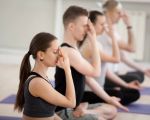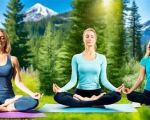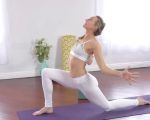- 1-Setting-Up-Your-Home-Yoga-Space
- 2-Establishing-a-Consistent-Yoga-Schedule
- 3-Choosing-the-Right-Yoga-Style-for-Your-Goals
- 4-Using-Guided-Resources-to-Support-Your-Practice
- 5-Listening-to-Your-Body-and-Progressing-Gradually
- 6-Creating-a-Mindful-Environment-and-Setting-Intentions
- 7-Stories-of-Successful-Home-Yoga-Practices
- 8-How-Free-Yoga-Links-Can-Help-You-Build-Your-Practice
1. Setting Up Your Home Yoga Space
Creating a dedicated space for your yoga practice at home is foundational for success. This doesn’t require a large room but should be a quiet, comfortable area where you feel relaxed and undistracted. Having a consistent spot signals your mind and body that it’s time to focus on yoga. Consider elements like natural light, a non-slip mat, and minimal clutter to enhance the environment.
Some practitioners add calming elements such as candles, plants, or gentle music to enrich their space. A well-designed yoga corner transforms your practice from a task to a cherished ritual.
2. Establishing a Consistent Yoga Schedule
Consistency is key when building a home yoga practice. Setting aside specific times each day or week helps form a routine that fits your lifestyle. Whether it’s a brief 15-minute morning session or a longer evening flow, regularity trumps duration for long-term benefits.
Scheduling your practice also helps overcome common obstacles like procrastination or distractions. Many find that linking yoga to daily habits—such as practicing right after waking up or before bedtime—makes consistency more manageable.
3. Choosing the Right Yoga Style for Your Goals
Yoga encompasses diverse styles, each suited to different needs and preferences. To build a sustainable practice, select a style aligned with your goals—be it stress reduction, flexibility, strength, or meditation.
For example, Hatha yoga offers gentle, foundational poses perfect for beginners, while Vinyasa provides a dynamic flow that can boost cardiovascular health. Restorative yoga focuses on relaxation and recovery, supporting mindfulness. Knowing what you want helps tailor your practice to stay motivated and engaged.
4. Using Guided Resources to Support Your Practice
Especially for beginners, guided yoga sessions via videos, apps, or online classes provide structure and confidence. They offer instruction on proper alignment, breathing techniques, and pose modifications, reducing the risk of injury and enhancing effectiveness.
Free Yoga Links is an excellent platform offering curated yoga resources suitable for all levels. Using such trusted guides helps build momentum and deepens understanding as you progress.
5. Listening to Your Body and Progressing Gradually
Yoga is a personal journey, and tuning into your body’s signals is essential. Avoid pushing too hard too fast; instead, embrace gradual progression that honors your limits while gently challenging your abilities.
Adapting poses with props or modifications prevents strain and fosters confidence. This mindful approach cultivates a positive relationship with your practice, encouraging persistence over perfection.
6. Creating a Mindful Environment and Setting Intentions
Beyond the physical space, fostering a mindful atmosphere supports concentration and presence. Begin sessions with clear intentions, whether it’s cultivating calm, building strength, or enhancing flexibility. This focus transforms yoga from exercise to holistic self-care.
Mindfulness techniques such as breath awareness and meditation integrated into your practice improve mental clarity and emotional balance.
7. Stories of Successful Home Yoga Practices
Many practitioners have shared how building a home yoga practice changed their lives. For instance, Emily, a busy mother, credits her daily 20-minute yoga routine with reducing anxiety and boosting energy. She emphasizes the importance of starting small and gradually expanding practice time.
Another story comes from David, who overcame chronic back pain through consistent home yoga, finding relief through gentle stretches and mindful breathing. These examples illustrate how home yoga adapts to diverse needs and lifestyles.
8. How Free Yoga Links Can Help You Build Your Practice
Free Yoga Links provides a wealth of tools, from beginner-friendly videos to advanced tutorials, helping you build a home yoga practice that’s enjoyable and effective. Their resources include pose guides, sequenced flows, and wellness tips designed to empower your journey.
By leveraging Free Yoga Links, you gain access to a supportive community and expert advice, making your home yoga practice sustainable and rewarding.








